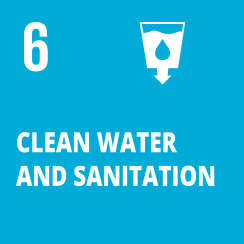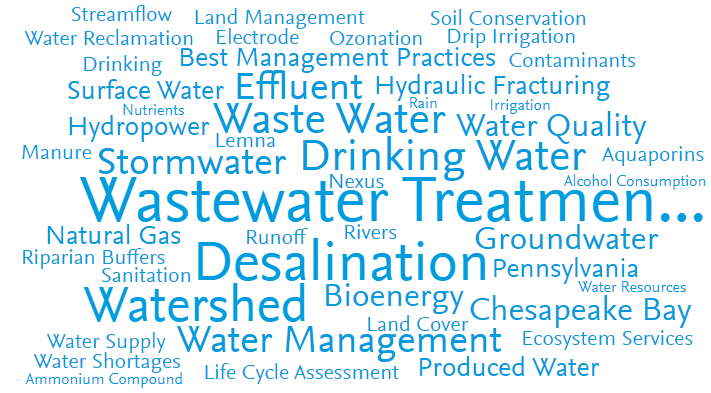
Ensure availability and sustainable management of water and sanitation for all
This goal targets providing universal and equitable access to safe and affordable drinking water; access to adequate and equitable sanitation and hygiene; reducing pollution, eliminating dumping and minimizing release of hazardous chemicals and materials; increasing water-use efficiency; implementing integrated water resources management; protecting and restoring water-related ecosystems; expanding international cooperation and capacity-building support to developing countries in water- and sanitation-related activities and programs; and, supporting and strengthening the participation of local communities in improving water and sanitation management. Learn more about this goal by reviewing the Targets & Indicators section below.

Source: SciVal.com | This word cloud was created using publications from Penn State researchers
Yes, the Penn State Water Resources Center provides research that local, national, and global governments can reference on challenges regarding water security and sustainability.
Yes, the Living Filter is an example of a sustainable extraction technology, as the filter recharges the regional water table using treated effluent.
Penn State University Park has a unique water reuse system called the Living Filter which takes treated effluent from the Penn State Waste Water Treatment Plant to irrigate a 600 acre plot of land. Discharging effluent into the Living Filter recharges the region’s water table and recycles the treated effluent. Additionally, there is an ongoing effort to install “purple pipes” which carries treated wastewater to meet irrigation and industrial water demands.
The university has a sustainable landscape implementation plan to conserve resources and increase carbon sequestration and canopy cover while reducing greenhouse gas emissions and maintenance that is required to maintain landscapes. The guiding principles of the plan are that: strategies shall be practical and incrementally implementable as resources allow; strategies shall promote economic sustainability and operational self-sufficiency; strategies shall aim to reduce greenhouse gas emissions and increase carbon sequestration; strategies shall aim to ecologically intensify campus while conserving resources; strategies shall aim to educate and engage the Penn State community.
Yes. Penn State has processes in place to prevent polluted water entering the water system. One such process is a policy SY40: Disposal of Pollutants in In University Sanitary Systems, which forbids the disposal of potentially dangerous or damaging pollutants down University water drains.
Yes. Water usage is monitored across all Penn State campuses on the “Water Dashboard” on Penn State Sustainability’s website.
Yes, Penn State Extension provides a wealth of information on good water management. Topics include pond and wastewater management, urban and residential stormwater, watershed protection and restoration, and Conservation Practices and Training.
The information can be found under the “Water” tab under the drop down selection labeled “Menu”.
Yes, Penn State Extension has a specific section dedicated to water supply and conservation. On Extension’s “Benefits from Water Conservation” webpage there are articles and videos topics such as conscious water usage and water education for youth. This free resource is available to the public as a way to promote conscious water usage in the wider community.
Targets & Indicators
Target 6.1: By 2030, achieve universal and equitable access to safe and affordable drinking water for all
- Indicator 6.1.1: Proportion of population using safely managed drinking water services
Target 6.2: By 2030, achieve access to adequate and equitable sanitation and hygiene for all and end open defecation, paying special attention to the needs of women and girls and those in vulnerable situations
- Indicator 6.2.1: Proportion of population using (a) safely managed sanitation services and (b) a hand-washing facility with soap and water
Target 6.3: By 2030, improve water quality by reducing pollution, eliminating dumping and minimizing release of hazardous chemicals and materials, halving the proportion of untreated wastewater and substantially increasing recycling and safe reuse globally
- Indicator 6.3.1: Proportion of domestic and industrial wastewater flows safely treated
- Indicator 6.3.2: Proportion of bodies of water with good ambient water quality
Target 6.4: By 2030, substantially increase water-use efficiency across all sectors and ensure sustainable withdrawals and supply of freshwater to address water scarcity and substantially reduce the number of people suffering from water scarcity
- Indicator 6.4.1: Change in water-use efficiency over time See metadata :
- Indicator 6.4.2: Level of water stress: freshwater withdrawal as a proportion of available freshwater resources
Target 6.5: By 2030, implement integrated water resources management at all levels, including through transboundary cooperation as appropriate
- Indicator 6.5.1: Degree of integrated water resources management
- Indicator 6.5.2: Proportion of transboundary basin area with an operational arrangement for water cooperation
Target 6.6: By 2020, protect and restore water-related ecosystems, including mountains, forests, wetlands, rivers, aquifers and lakes
- Indicator 6.6.1: Change in the extent of water-related ecosystems over time
Target 6.a: By 2030, expand international cooperation and capacity-building support to developing countries in water- and sanitation-related activities and programs, including water harvesting, desalination, water efficiency, wastewater treatment, recycling and reuse technologies
- Indicator 6.a.1: Amount of water- and sanitation-related official development assistance that is part of a government-coordinated spending plan
Target 6.b: Support and strengthen the participation of local communities in improving water and sanitation management
- Indicator 6.b.1: Proportion of local administrative units with established and operational policies and procedures for participation of local communities in water and sanitation management







